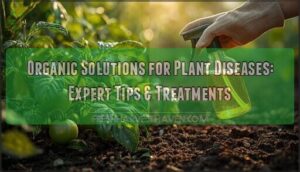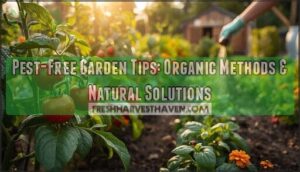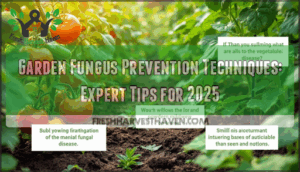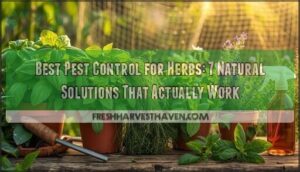This site is supported by our readers. We may earn a commission, at no cost to you, if you purchase through links.
Plant diseases can devastate a garden in days, but synthetic fungicides often create collateral damage, wiping out beneficial microbes and leaving chemical residues on your harvest. The good news: organic solutions for plant diseases deliver measurable results without poisoning your soil ecosystem.
Research shows milk spray alone can slash foliar symptoms by 50–70% while boosting marketable yields, and compounds like neem oil achieve up to 90% infection suppression in controlled trials.
Your defense strategy starts with understanding how these treatments work at the cellular level—raising leaf surface pH to block spore germination, disrupting fungal respiration, or introducing competitive microorganisms that crowd out pathogens.
The most effective approach combines immediate intervention with long-term soil building, creating an environment where diseases struggle to establish while your plants thrive.
Table Of Contents
Key Takeaways
- Organic fungicides like milk spray (25-30% solution) and neem oil achieve 50-90% disease suppression rates without destroying beneficial soil microbes or leaving chemical residues on edible crops.
- Prevention through strategic practices—proper plant spacing for airflow, morning watering to reduce pathogen risk, and crop rotation—cuts soil-borne diseases by up to 50% while building long-term resistance.
- Healthy soil containing diverse beneficial microorganisms (enhanced 40% through organic practices) creates natural disease suppression by outcompeting pathogens before they establish infections.
- Combining immediate organic interventions with soil-building amendments like compost tea and biocontrol agents (Trichoderma, Bacillus subtilis) delivers both rapid disease control and sustainable plant immunity over time.
Effective Organic Treatments for Plant Diseases
When plant diseases strike, you don’t need to reach for synthetic chemicals to restore your garden’s health. Several organic treatments work by disrupting fungal life cycles, altering leaf surface conditions, or strengthening your plants’ natural defenses.
Here are four proven methods that combine effectiveness with environmental safety.
Milk Spray as a Natural Fungicide
You can employ milk spray as a powerful natural fungicide against powdery mildew and other fungal diseases. The fungicide mechanism works through lactoferrin proteins and pH modification that prevent spore germination.
Field trials show that 25–30% milk-to-water solutions reduce foliar symptoms by 50–70% while boosting marketable yield by 40–50%. Apply weekly for best disease resistance, knowing this organic treatment won’t harm beneficial insects.
For more information on preventing powdery mildew, consider using milk spray treatments.
Using Baking Soda to Prevent Fungal Growth
You can use baking soda as an organic fungicide by mixing 1 tablespoon per gallon of water to prevent powdery mildew and other fungal diseases. This natural disease control solution raises leaf surface pH, blocking spore germination—research shows it reduces wheat leaf rust severity from 11.4% to 2.2%.
Apply early in the disease cycle and reapply after rain, since baking soda washes away easily. For more information on using baking soda, refer to the fungicide use guide to understand its effectiveness against various fungal diseases.
Applying Neem Oil for Disease Control
While baking soda targets surface fungi, neem oil works deeper—inhibiting fungal spore germination and reducing infection rates up to 90%. This biopesticide regulation-approved organic solution addresses both fungal disease management and natural pest control simultaneously.
Application protocol for neem oil efficacy:
- Mix 5–10 ml per liter of water for ideal fungal disease management
- Apply preventively every seven days targeting leaf surfaces
- Reapply after rainfall since neem extraction methods create biodegradable formulations
- Expect 70% disease suppression within three treatment cycles
Benefits of Sulfur Dust and Cornell Formula
Sulfur dust benefits extend beyond neem’s scope, delivering 75–90% powdery mildew suppression in vineyard trials while disrupting fungal respiration at the cellular level.
For broader fungal disease control, the Cornell formula—combining hydrated lime, sulfur fungicide, and water—achieves 87% efficacy against resistant strains when applied biweekly.
Both organic solutions support sustainable crop management without chemical residues, keeping your organic farming methods certification-compliant.
Natural Pest and Disease Prevention Strategies
Prevention beats treatment every time regarding plant diseases. You can protect your garden before problems appear by using strategic combinations of plants, homemade sprays, and natural soil amendments that disrupt pest and disease cycles.
Let’s look at four proven prevention methods that create a healthier growing environment from the ground up.
Companion Planting for Disease Resistance
Certain plant pairings act as biological shields, disrupting disease cycles through natural chemical warfare and microbial balance. You can leverage these ecosystem services through strategic crop diversity:
- Tomato-basil pairings reduce early blight by 20% while enhancing soil health
- French marigolds suppress nematodes up to 90% in peppers and potatoes
- Thyme intercropping cuts Verticillium wilt incidence by 60%
- Allium species emit sulfur compounds that repel disease-carrying pests
These plant interactions strengthen your garden’s defense system naturally.
Garlic Spray for Fungal and Bacterial Issues
Garlic extract delivers powerful fungal inhibition through allicin properties, disrupting biofilm formation at concentrations as low as 0.5–2%. This natural remedy works best when applied early morning in your organic gardening routine.
You’ll target both fungal diseases and bacterial diseases effectively, with field applications every seven days during active growth.
However, phytotoxicity risks emerge above 10% concentration—always test diluted garlic spray on small leaf sections first.
Diatomaceous Earth for Pest Management
This mineral powder transforms organic gardening through its razor-sharp microscopic silica particles, which puncture insect exoskeletons and trigger dehydration without chemical resistance concerns.
You’ll apply food-grade diatomaceous earth in thin layers around plant bases for effective pest control against crawling insects.
Beyond its DE mechanism for crop protection, it enhances soil aeration and supplies trace minerals that strengthen plant cell walls, supporting natural pest control in organic farming systems.
Beneficial Nematodes in Soil Pest Control
You’ll employ microscopic warriors from soil ecology when you deploy entomopathogenic nematodes—species like Steinernema carpocapsae and Heterorhabditis bacteriophora deliver targeted pest eradication within 24–48 hours through bacterial injection into host larvae.
This biocontrol method maintains ecological balance while bolstering natural pest control:
- Apply 5 million nematodes per 2,000 sq. ft. for preventative protection
- Target white grubs, cutworms, and fungus gnat larvae specifically
- Maintain soil temperatures between 70°F and 86°F for peak activity
- Reapply at seven-day intervals if pest populations persist
Their nematode biology enhances soil health, decomposing organic matter while eliminating harmful insects without chemical residues, bolstering both plant immunity and beneficial insect populations through proper nematode application timing.
Essential Tips for Preventing Plant Diseases
Prevention beats treatment every time regarding plant diseases. The good news is that you don’t need a chemistry degree or expensive equipment to keep your garden healthy.
Here are four essential practices that create an environment where diseases struggle to take hold.
Regular Plant Inspection and Monitoring
Think of plant sensors and monitoring systems as your early warning radar—they catch trouble before your eyes can. Research shows detection within 48–72 hours of pathogen attack, often 3–4 days before visible symptoms appear.
Regular crop scouting combined with precision farming technology bolsters disease forecasting accuracy rates up to 90–100%, bolstering your plant health management strategy and strengthening disease prevention through timely organic disease management interventions.
Watering Techniques to Avoid Root Rot
You can slash root rot by 60% with soil moisture sensors that tell you exactly when to water—aim for tension between 40–60 kPa. Deep, infrequent watering builds 45% stronger roots than daily sprinkles, while morning irrigation timing cuts pathogen risk in half.
Your drainage systems matter too: raised beds reduce waterlogging by 80%, and containers without proper drainage show 75% more root rot cases.
Enhancing Air Circulation and Proper Spacing
After dialing in your watering, don’t overlook airflow management and plant spacing. Ventilation systems and smart crop layout keep humidity low, cutting powdery mildew and leaf spot by drying leaves quickly.
Consistent air circulation between 0.3–0.5 meters per second prevents disease, while companion planting and moderate spacing encourage healthy growth, supporting your overall disease prevention strategy.
Crop Rotation and Soil Cleanliness
Beyond airflow, crop rotation and soil cleanliness build disease suppression into your system. Rotating crops disrupts pathogen cycles—shifting from legumes to cereals to root crops reduces soil-borne diseases by up to 50% while boosting yields 20% over monoculture.
Key rotational benefits for soil health include:
- Breaking disease cycles through crop diversity
- Increasing beneficial microbes by 29%
- Elevating soil nitrogen 20–40% with legumes
- Reducing pathogen loads through ecological balance
- Enhancing long-term soil renewal and productivity
Remove plant debris between seasons to prevent pathogen carryover.
Building Healthy Soil for Disease Suppression
Your soil isn’t just dirt—it’s a living ecosystem that can make or break your plants’ ability to fight off disease. When you build healthy soil packed with beneficial microorganisms and balanced nutrients, you’re creating a natural defense system that works around the clock.
Healthy soil is a living ecosystem that builds a natural defense system to protect your plants from disease around the clock
Let’s look at four proven strategies that transform ordinary garden soil into a disease-suppressing powerhouse.
Organic Compost and Microbial Amendments
Compost tea and organic amendments transform soil health by introducing beneficial microorganisms that actively combat pathogens. When you enrich your soil with compost, you’re boosting microbial activity by up to 10%, while suppressing diseases in over half of documented cases. Designer composts containing wood chips or bark deliver enhanced fungal suppression compared to generic options.
| Amendment Type | Key Benefit |
|---|---|
| Green waste compost | Increases bacterial abundance, improves microbial diversity |
| Designer composts (wood/bark) | Enhanced pathogen suppression, targets specific diseases |
| Enriched biofertilizers | Doubles mycorrhizal colonization, enhances nutrient uptake |
| Compost tea applications | Shifts microbiome toward disease-suppressive consortia |
Maintaining Soil PH and Fertility
Your soil pH balance directly influences microbial activity and nutrient bioavailability, which are essential for disease suppression. Aim for pH 6–7 to support beneficial microbes that naturally combat pathogens. You can adjust pH organically using:
- Agricultural lime for gradual, long-lasting alkalinity
- Wood ash for quick pH elevation (0.25-inch layer)
- Baking soda solution (1 tablespoon per gallon) for rapid correction
- Regular compost applications to buffer pH swings
- Periodic soil testing to maintain target ranges
High organic matter benefits soil health by enriching microbial diversity and improving disease resistance naturally.
Impact of Organic Farming on Disease Resistance
Shifting to organic gardening methods fundamentally reshapes your soil ecosystem, building microbial balance that naturally strengthens disease prevention. Organic practices boost beneficial microbial diversity by 40%, creating disease suppression through competitive exclusion of pathogens.
You’ll see enhanced plant immunity as diverse bacterial networks—especially Alphaproteobacteria—establish ecological resilience. This microbial richness translates directly into sustainable gardening success, with organic soils demonstrating outstanding resistance to root rot and other soil-borne diseases while maintaining long-term soil health.
Leveraging Biocontrol Agents
You can employ powerful fungal agents like Trichoderma and bacterial powerhouses such as Bacillus subtilis to suppress disease through competitive exclusion and antimicrobial production. These microbial formulations work through multiple biocontrol mechanisms, achieving over 60% disease suppression in field trials.
When combined with compost tea and soil amendments containing beneficial microorganisms, these biological treatments boost your garden’s natural defense systems markedly.
Top Organic Products for Disease Management
You’ve built the foundation with healthy soil and preventive practices, but sometimes your plants need direct intervention to combat disease. The right organic products can make all the difference between losing a crop and saving it.
Here are five proven solutions that belong in every organic gardener’s arsenal.
1. Natural Neem Oil Plant Spray
You’ll find neem oil to be one of your most adaptable organic treatments, functioning as both a natural fungicide and pest deterrent for your plants. Cold-pressed neem oil contains azadirachtin, which disrupts fungal spore germination while repelling aphids, mealybugs, and spider mites.
Apply diluted neem oil spray every 7 to 14 days as a preventative measure, following plant spray recipes that commonly recommend one teaspoon per quart of water.
This natural remedy prevents powdery mildew, black spot, and rust while promoting healthy plant growth through its systemic disease control properties.
2. Organic Horticultural Spray Oil Protector
Refined mineral oils deliver a one-two punch against both insects and fungal diseases, making them essential organic gardening tools in your pest control arsenal.
You can apply horticultural spray oil year-round to smother aphids, spider mites, and whiteflies while suppressing powdery mildew and leaf spot. These self-emulsifying formulations achieve 92% purity, breaking down rapidly without toxic residues—you’ll harvest immediately after application.
For best disease suppression, spray a 2% solution weekly with complete leaf coverage, as effectiveness stops once the oil dries.
3. Boogie Brew Organic Compost Tea
Compost tea benefits extend far beyond basic nutrition. Aerated brewing transforms Boogie Brew into a living microbial powerhouse that actively suppresses plant diseases. You’ll introduce up to 10^7 beneficial microbes per milliliter when you brew this veeganic concentrate for 24 hours, creating competitive exclusion against pathogens like Botrytis and pythium.
Field trials document 60–80% reductions in damping-off and powdery mildew when you apply weekly drenches, while plant immunity increases through natural antibiotic production.
This organic fertilizer enhances soil health by mineralizing nutrients and restoring microbial balance without harming beneficial organisms.
4. Unsulfured Blackstrap Molasses Bulk Jug
Unsulfured blackstrap molasses transforms your soil into a disease-resistant fortress by fueling explosive microbial growth. When you apply 45 mL per gallon, you’ll increase beneficial bacteria populations that outcompete pathogens like nematodes and fungal infection control threats.
This cost-effective bulk jug delivers calcium, magnesium, and iron while chelating locked nutrients into absorbable forms.
Field studies confirm 50–75 kg/ha applications boost plant vigor and natural disease suppression by 20%, making molasses benefits essential for organic plant disease treatments and long-term soil health maintenance.
5. Vivosun Submersible Water Fountain Pump
Beyond soil amendments, water management directly impacts disease prevention in hydroponic systems and container gardens.
The Vivosun Submersible Water Fountain Pump delivers 800 GPH at just 24 watts, moving oxygenated water through your setup while operating at whisper-quiet 28 decibels. Its ceramic shaft withstands continuous use in acidic nutrient solutions, and the adjustable flow rate lets you fine-tune water circulation for different plant disease management needs.
At $39.99, this submersible tech aids organic disease management by preventing stagnant conditions where pathogens thrive, maintaining pump efficiency that protects soil health through proper drainage and fountain design versatility.
Frequently Asked Questions (FAQs)
How does mulching affect fungal disease development?
Mulching techniques dramatically influence fungal diseases through soil moisture control and fungal community shift. When you apply organic mulch benefits at proper depths (2–4 inches), disease suppression mechanisms activate, while improper application triggers pathogen outbreaks exceeding 300%.
What role does sunlight play in disease prevention?
While fungi scheme in the shadows, your garden’s free light show moonlights as a disease-fighting powerhouse.
UV radiation disrupts pathogen DNA, while solar disinfection heats leaf surfaces past fungal comfort zones, naturally suppressing powdery mildew and blight prevention through photoperiod control.
Are there organic treatments safe for edible herbs?
You can safely protect edible herbs with milk fungicide, neem oil, baking soda solutions, and garlic spray—all organic plant disease treatments with natural resistance properties.
Compost tea and herbal remedies offer additional protection without compromising harvest safety.
How quickly do organic fungicides show visible results?
You’ll generally see visible results from organic fungicides within 3 to 14 days, depending on the product and disease stage.
Preventive applications work fastest, while curative treatments targeting established powdery mildew require patience.
Conclusion
The theory that organic solutions for plant diseases can’t match synthetic performance collapses under scrutiny—your garden proves otherwise when milk spray cuts infection rates in half and neem oil blocks 90% of fungal activity.
You’ve now got the biological toolkit to dismantle pathogens without destroying your soil’s living architecture. Start with one treatment, watch your plants respond, and let measurable results—not marketing claims—guide your next move.
- https://extension.psu.edu/plant-disease-basics-and-diagnosis
- https://www.sciencedirect.com/topics/agricultural-and-biological-sciences/anthracnose
- https://extension.umn.edu/diseases/late-blight
- https://www.houzz.com/discussions/1708338/milk-water-mix-for-mildew
- https://www.chemijournal.com/archives/2020/vol8issue2/PartN/8-1-658-218.pdf












